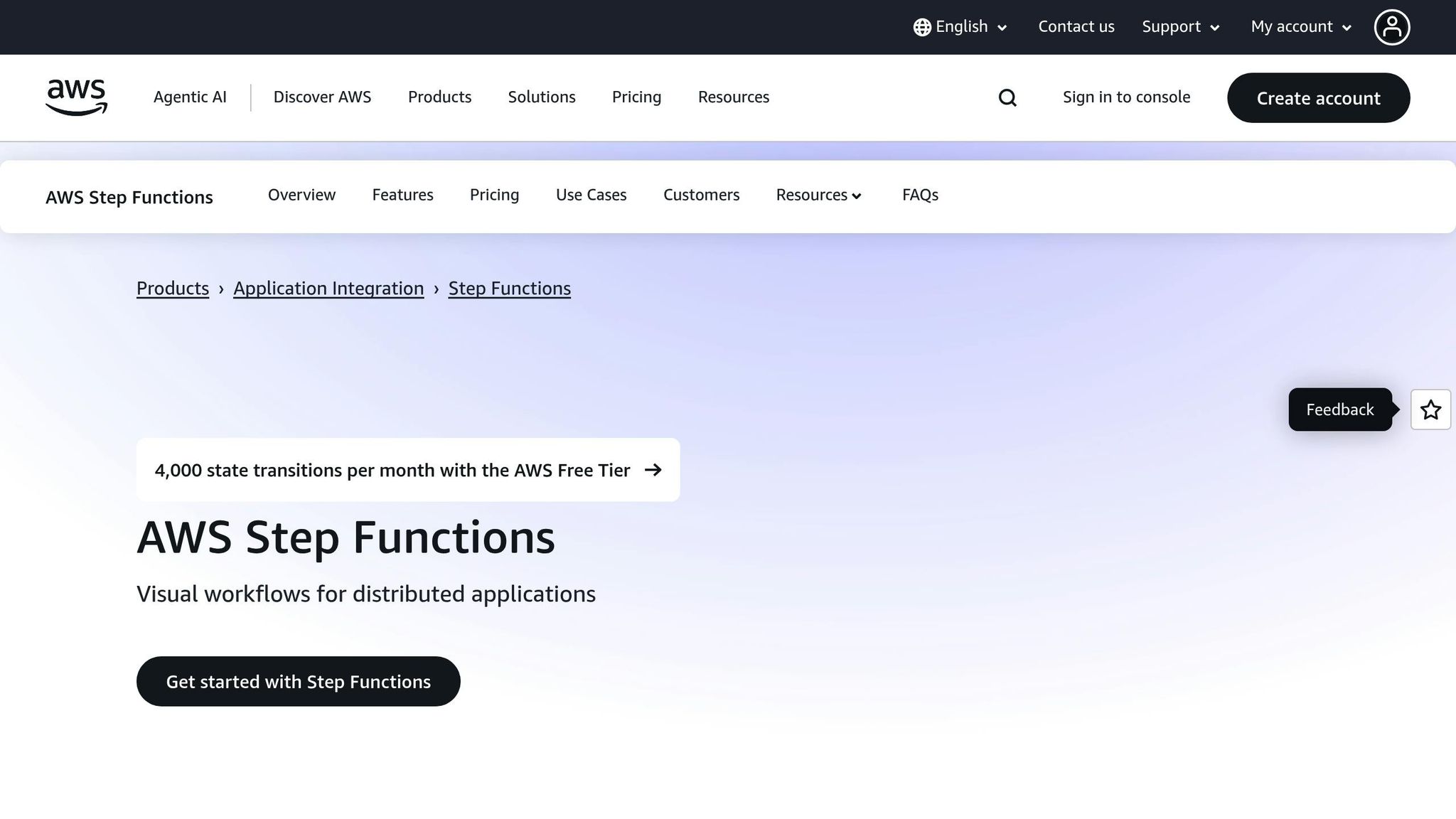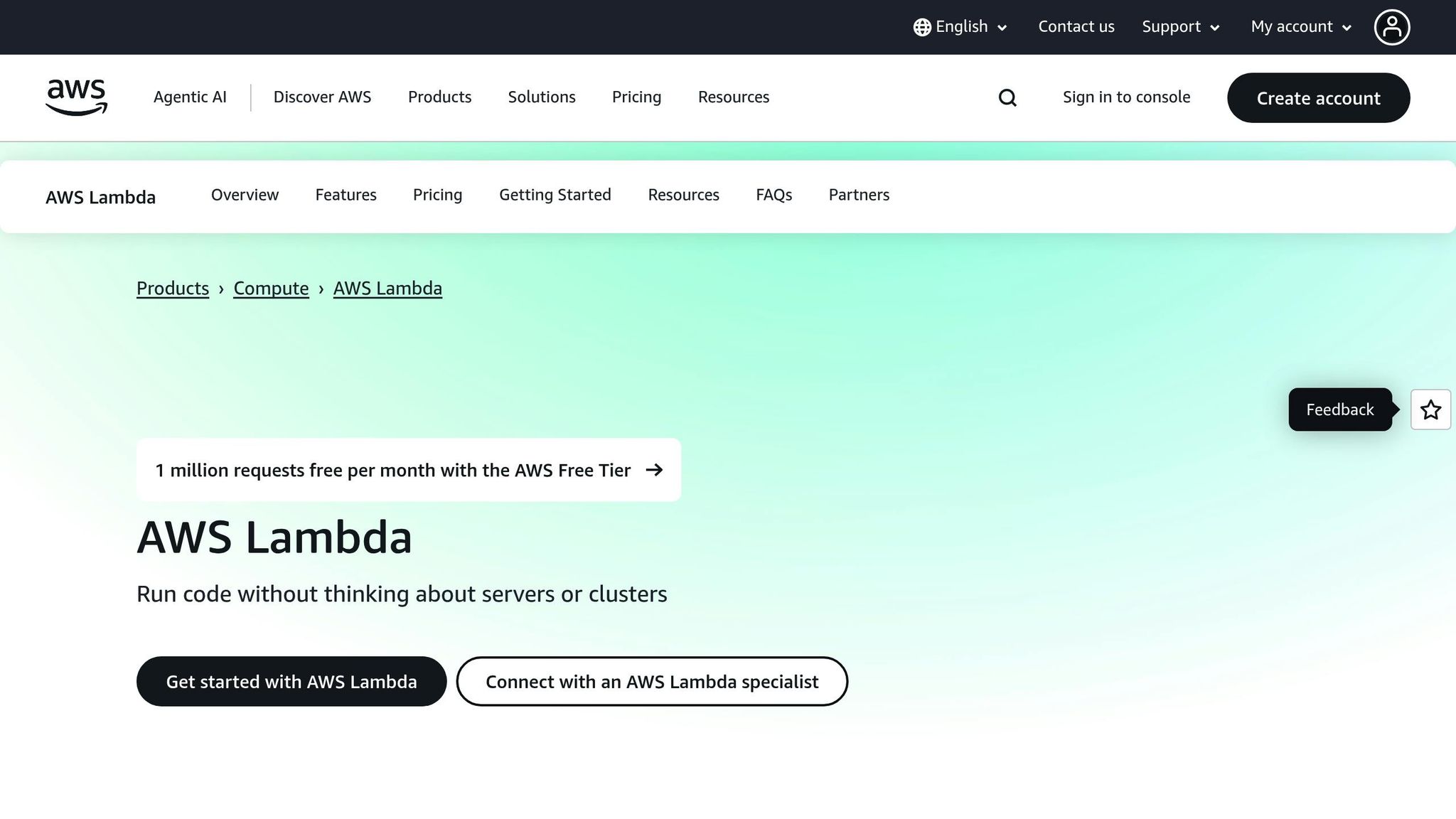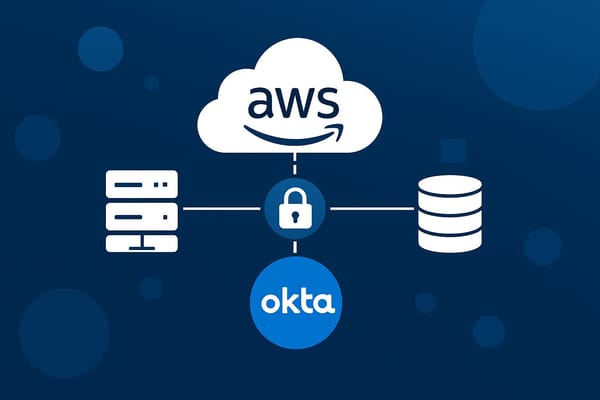AWS Step Functions vs Lambda: Workflow Automation Comparison
Explore the differences between AWS Lambda and Step Functions for workflow automation, focusing on use cases, costs, and complexities.

When deciding between AWS Lambda and AWS Step Functions for workflow automation, the choice depends on your business needs:
- AWS Lambda: Ideal for simple, event-driven tasks like file processing or sending notifications. It’s cost-effective (£0.20 per million requests) and scales automatically but has a 15-minute execution limit and no built-in state management.
- AWS Step Functions: Best for coordinating complex, multi-step workflows with built-in error handling, visual monitoring, and support for long-running processes (up to 1 year). However, it’s more expensive (£0.025 per 1,000 state transitions) and has a steeper learning curve.
Quick Comparison
| Feature | AWS Lambda | AWS Step Functions |
|---|---|---|
| Primary Use Case | Single tasks | Multi-step workflows |
| Execution Time | Max 15 minutes | Max 1 year |
| Error Handling | Custom coding required | Built-in retries & catch blocks |
| State Management | Stateless | Built-in |
| Cost Model | Per request + compute time | Per state transition |
| Ease of Use | Easier to implement | Requires workflow design skills |
For small, quick tasks, Lambda is the way to go. For intricate workflows or processes needing coordination, Step Functions is the better choice.
AWS Step Functions + Lambda Tutorial - Step by Step Guide in the Workflow Studio

What is AWS Lambda

AWS Lambda is a serverless compute service that lets you run your code in response to events, without the need to manage servers or infrastructure. Think of it as a pay-as-you-go service: you upload your code, and AWS takes care of everything else, from scaling to applying security updates.
Lambda operates on an event-driven model. For example, when an event like a file upload occurs, Lambda triggers your function and charges only for the milliseconds of compute time used. This makes it an appealing option for small and medium-sized businesses (SMBs) in the UK, especially those looking to keep costs low while avoiding the hassle of server management.
Each Lambda function is stateless, meaning every execution is independent. This design allows for seamless scalability, handling anything from zero to thousands of concurrent executions without requiring any manual configuration. For SMBs dealing with unpredictable traffic patterns, this flexibility can lead to considerable cost savings compared to maintaining servers that might sit idle during quieter periods.
Here are some of the standout features that make AWS Lambda a popular choice for SMBs.
AWS Lambda Key Features
Lambda’s event-driven architecture is perfect for reactive workflows. It integrates natively with over 200 AWS services, enabling you to automate tasks like processing uploaded files, sending notification emails, or updating databases. And it does all this in milliseconds after an event occurs.
One of Lambda’s most appealing aspects is its automatic scaling. There’s no cost when your function isn’t running. But when demand spikes - such as during a big sale or a holiday rush - Lambda can handle up to 1,000 concurrent executions by default, with options to increase this limit. This eliminates the need to pay for peak server capacity that often goes unused.
Cost efficiency is another major benefit. Lambda charges £0.0000167 per GB-second of compute time and £0.20 per million requests. For many SMBs, this means monthly bills that are often just a few pounds. Plus, the free tier includes 1 million requests and 400,000 GB-seconds of compute time per month, which is often enough to cover development and testing.
Lambda supports a variety of programming languages, including Python, Node.js, Java, C#, Go, and Ruby. This means your developers can use tools they’re already comfortable with. It also includes built-in monitoring through CloudWatch, giving you insights into performance, errors, and costs without extra setup.
AWS Lambda Limitations
While Lambda has plenty of advantages, it does have some limitations that might make certain tasks more challenging.
The stateless nature of Lambda functions can complicate multi-step workflows. Functions cannot directly share data or maintain state between executions. If you need to coordinate multiple steps or track progress, you’ll need external storage solutions like DynamoDB or S3, which can add complexity and potential points of failure.
Handling errors in multi-function workflows can also be tricky. If a function fails halfway through, there’s no built-in way to retry just that failed step or roll back previous actions. This means you’ll need to add custom error-handling logic for these scenarios.
Another constraint is the execution time limit. Lambda functions can only run for a maximum of 15 minutes. For tasks like processing large files, migrating data, or performing complex calculations, you may need to break the work into smaller chunks or consider other services.
Cold starts - the delay that occurs when a function hasn’t been used for a while - can add a few seconds of latency. While this might not matter for background tasks, it can be an issue for user-facing applications that require instant responses.
Finally, Lambda lacks a visual workflow interface. Unlike traditional workflow tools, there’s no built-in way to see how your functions connect or to visualise the overall process. This can make troubleshooting and maintenance harder, especially as your automation grows more complex or when new team members need to understand your setup.
What is AWS Step Functions
AWS Step Functions is a serverless orchestration service designed to streamline workflows across a variety of applications. Unlike AWS Lambda, which focuses on executing single tasks, Step Functions coordinates multiple steps across different AWS services, enabling workflows that can run anywhere from a few minutes to up to a year.
Workflows in Step Functions are defined as state machines using JSON. Each step, or "state", represents a specific action or decision point. This setup allows integration with over 200 AWS services, making it capable of handling complex automation that goes beyond the scope of individual Lambda functions.
Step Functions provides a visual workflow model, where each state performs tasks, makes decisions, runs processes in parallel, or waits for external triggers. This coordination is particularly useful for businesses that need to automate intricate processes involving multiple systems. It's this ability to orchestrate complex workflows that sets Step Functions apart from Lambda.
The service offers two workflow types tailored to different needs. Standard Workflows are ideal for long-running processes requiring detailed audit trails and exactly-once execution, such as compliance checks or order management. Meanwhile, Express Workflows are optimised for short, high-volume tasks that complete within five minutes, making them perfect for real-time data processing or IoT applications.
AWS Step Functions Key Features
One standout feature of Step Functions is its visual workflow editor, which provides a clear graphical representation of your process. This makes it easier to identify bottlenecks, explain workflows to stakeholders, and train team members.
Another major advantage is its built-in error handling. If a state fails, you can configure automatic retries with features like exponential backoff, catch specific error types, or reroute failures to alternative paths. This ensures your workflows can gracefully handle temporary issues like network timeouts.
Step Functions also shines in parallel processing. You can execute multiple tasks simultaneously - whether that’s processing different parts of a dataset or making several API calls at once - and then synchronise the results before moving forward. This significantly reduces overall processing times.
The service also manages data flow between steps automatically, maintaining execution context. It supports three integration patterns for service communication: Request Response for quick API calls, Run a Job (.sync) for long-running tasks, and Wait for a callback for external triggers. This flexibility allows you to build workflows that suit your specific needs.
Performance-wise, Express Workflows can handle up to 100,000 executions per second, while Standard Workflows support around 2,000 executions per second - more than adequate for most small to medium-sized businesses.
AWS Step Functions Limitations
While Step Functions offers powerful workflow management, it’s not always the right tool for simpler tasks. For example, resizing an image upon upload to S3 might be better handled by a single Lambda function, which would be more straightforward and cost-effective.
Speaking of costs, Standard Workflows charge based on the number of state transitions. If your workflows are complex or run frequently, these costs can add up quickly.
Another consideration is the learning curve. Designing effective state machines, mastering the Amazon States Language, and troubleshooting intricate workflows require specialised knowledge, which could delay implementation for teams new to the service.
There’s also a data size limitation - Step Functions can only pass up to 256KB of data between states. For larger datasets, you’ll need to store the data in S3 and pass references instead, which adds extra steps to your architecture.
Additionally, execution history for Standard Workflows is only retained for 90 days. Businesses needing long-term audit trails for compliance or analysis must export this data before it’s automatically deleted.
Finally, while the visual editor simplifies workflow design, debugging can still be challenging. Identifying the root cause of a failure deep within a nested parallel branch often requires digging through execution logs, which can be time-consuming.
AWS Step Functions vs Lambda Comparison
When deciding between AWS Step Functions and Lambda for workflow automation, understanding their differences is crucial. Each service offers distinct strengths, and the choice ultimately depends on your specific needs and use case.
The core difference lies in their focus: Lambda is designed for single-purpose tasks like file uploads, sending emails, or updating databases, while Step Functions excel at orchestrating complex, multi-step workflows. The latter includes features like conditional logic and parallel processing, making it ideal for more intricate processes.
Another key distinction is execution duration. Lambda functions are capped at 15 minutes, making them suitable for quick tasks, whereas Step Functions can run workflows for up to a year. This makes Step Functions a better choice for long-running processes like compliance audits or detailed reporting.
Error handling also sets these services apart. Lambda requires developers to write custom error-handling code, which can be time-consuming. In contrast, Step Functions provide built-in error management tools, such as retries, catch blocks, and alternative paths, simplifying the process and increasing reliability for more complex workflows.
Feature Comparison Table
| Feature | AWS Lambda | AWS Step Functions |
|---|---|---|
| Primary Use Case | Single-purpose functions | Orchestrating multi-step workflows |
| Maximum Execution Time | 15 minutes | 1 year |
| State Management | Stateless | Built-in state management |
| Error Handling | Custom code required | Built-in retry and catch mechanisms |
| Parallel Processing | Custom coordination needed | Supported natively |
| Visual Monitoring | CloudWatch logs only | Visual workflow dashboard |
| Data Passing | Event-driven parameters | Automatic state transitions |
| Service Integration | Direct API calls | 200+ AWS services via connectors |
| Pricing Model | Per request + compute time | Per state transition |
| Learning Curve | Moderate (coding required) | Steeper (state machine design) |
Performance and Cost Analysis
Diving deeper into performance and cost highlights some important trade-offs. Lambda pricing starts at £0.0000167 per GB-second of compute time, plus £0.20 per million requests. Step Functions, on the other hand, charge based on the workflow type. Standard Workflows cost £0.025 per 1,000 state transitions, while Express Workflows charge £1.00 per million requests plus £0.00001667 per GB-second. For example, a workflow with 10 states running 1,000 times monthly would cost £0.25 in state transitions alone.
From a performance perspective, Lambda functions are nearly instantaneous but may experience cold start delays of 100-1,000 milliseconds when scaling from zero. Step Functions Express Workflows support up to 100,000 executions per second with minimal latency, while Standard Workflows handle 2,000 executions per second and offer detailed audit trails.
For simple, high-frequency tasks, Lambda often offers better performance and cost efficiency. For instance, a payment processing system handling 50,000 transactions daily would benefit from Lambda's straightforward execution model. However, complex workflows with multiple decision points are better suited for Step Functions. Its built-in orchestration capabilities save development time and improve reliability, even if it comes at a higher cost.
Memory and compute flexibility also play a role. Lambda allows you to allocate memory based on workload needs, helping optimise performance. Step Functions, meanwhile, coordinates other services without consuming compute resources directly, which simplifies resource planning.
Debugging and monitoring differ significantly between the two. Lambda relies on CloudWatch logs for debugging, which can become costly for verbose applications. Step Functions, however, includes visual execution history as part of its service, making it easier to troubleshoot intricate workflows without incurring additional monitoring costs.
Typically, the choice between these services hinges on workflow complexity. For workflows with fewer than 5-7 steps, Lambda's simplicity and lower costs are hard to beat. Beyond that, Step Functions' orchestration capabilities often justify the higher price tag by reducing development effort and enhancing overall reliability.
SMB Use Cases and Recommendations
Understanding when to use Lambda versus Step Functions becomes clearer when you consider real-world scenarios. The choice often depends on the complexity of the workflow, budget constraints, and the expertise available within your team.
Common SMB Workflow Examples
E-commerce order processing is a frequent automation need for UK SMBs. Imagine an online retailer managing tasks like validating payments, checking inventory, updating stock levels, sending confirmation emails, and triggering fulfilment. For workflows with just a few steps, Lambda can efficiently handle these tasks. However, when additional factors such as fraud detection, multiple payment methods, or international shipping calculations come into play, Step Functions is better equipped to manage the added complexity.
Invoice management and approval workflows often involve routing invoices through various departments - department heads, finance teams, and final approval stages. Lambda is well-suited for individual tasks like generating PDFs or sending notifications. But when workflows require multiple approval paths, such as varying routes based on invoice amounts or supplier types, Step Functions shines by coordinating the entire process seamlessly.
Customer onboarding processes typically involve several touchpoints and decision branches. For example, a SaaS company might need to verify email addresses, process payments, provision accounts, send welcome emails, and schedule follow-ups. If there are additional branches for free trials or tiered services, the workflow becomes more intricate. Step Functions can manage these branching scenarios more effectively than manually coordinating multiple Lambda functions.
Data validation and processing pipelines are common for SMBs dealing with customer data or compliance requirements. Take a financial services firm, for instance - they might need to validate incoming data, check it against compliance rules, flag anomalies, and generate reports. While Lambda can handle individual validation rules, Step Functions offers better oversight of the entire pipeline, especially for businesses needing clear audit trails to meet regulations like GDPR.
Microservices coordination becomes critical as SMBs scale their operations. A logistics company, for example, might have separate services for route optimisation, driver scheduling, customer notifications, and billing. Lambda works well for powering individual microservices, but Step Functions provides superior coordination, particularly when these services need to work together in sequence or handle failures gracefully.
These examples highlight how different scenarios can influence whether Lambda or Step Functions is the better choice.
Service Selection Guide for SMBs
Choosing between Lambda and Step Functions depends on the complexity of the workflow and the specific needs of the business. For workflows with only a few steps, straightforward logic, and short execution times (under 10 minutes), Lambda is often the go-to option. It’s easier to implement, has predictable costs, and suits teams with basic programming skills.
On the other hand, Step Functions is ideal for workflows with conditional logic, parallel processing, or long-running tasks. For example, if a process requires multiple execution paths based on data values, simultaneous task execution, or spans hours or days, Step Functions offers capabilities that would be challenging to replicate with Lambda alone.
Budget is another important factor. Lambda’s per-request pricing model is perfect for high-frequency, short-duration tasks, such as handling a customer service chatbot’s queries. Step Functions, however, tends to be more cost-effective for less frequent but more intricate workflows, where its orchestration capabilities justify the higher per-state-transition costs.
Technical expertise also plays a major role. Lambda’s function-based approach is straightforward for developers with a solid programming background. Step Functions, by contrast, requires familiarity with state machine concepts and JSON-based workflow definitions. That said, its visual workflow designer can make it easier for less technical team members to understand and contribute.
When it comes to error handling, Lambda requires custom solutions, while Step Functions provides built-in retries and catch mechanisms. This makes Step Functions a strong choice for mission-critical processes.
Monitoring and compliance needs vary among UK SMBs. Lambda relies on CloudWatch for monitoring, which can become costly for applications with extensive logging. Step Functions, however, includes features like visual execution history and detailed state tracking, making it an excellent option for businesses requiring comprehensive audit trails for regulatory compliance.
Finally, integration requirements can influence the decision. Step Functions offers native connectors to many AWS services, simplifying complex integrations without extra coding. Lambda, while more flexible for custom solutions, often requires additional manual integration work.
For additional guidance, check out AWS Optimization Tips, Costs & Best Practices for Small and Medium Sized Businesses.
A practical strategy for SMBs is to start with Lambda for simpler workflows and transition to Step Functions as needs grow. This approach allows teams to gain experience with AWS automation while keeping initial costs low. Over time, many SMBs successfully expand their use of Step Functions for their most complex workflows as their expertise and business requirements evolve.
Conclusion
AWS Step Functions and Lambda each bring distinct strengths to the table, catering to different levels of workflow complexity and budget considerations. Lambda shines when it comes to straightforward, single-purpose tasks with predictable costs and quick deployment. This makes it a great fit for UK small and medium-sized businesses (SMBs) handling tasks like data validation, file processing, or API responses. On the other hand, Step Functions is the go-to option for more complex workflows involving multiple decision points, parallel processing, or long-running operations. Its built-in error handling is particularly valuable for businesses that need clear audit trails to meet UK regulatory requirements.
When it comes to cost, Lambda’s pay-per-execution model is ideal for high-frequency, short-duration tasks. Meanwhile, Step Functions, though carrying higher costs, becomes more cost-effective for intricate workflows where orchestration capabilities are key. Striking the right balance between cost and performance often depends on having the right expertise and selecting the appropriate orchestration approach.
From a skills perspective, Lambda requires strong programming knowledge but offers a relatively simple implementation process. Step Functions, while demanding some understanding of state machine concepts, provides a visual interface that can make it more accessible to less technical team members. Many UK SMBs find success by using Lambda for individual tasks or simple workflows, then incorporating Step Functions for coordinating multiple services or managing processes that span longer timeframes. This step-by-step approach allows businesses to scale their automation efforts effectively while keeping a close eye on costs.
Ultimately, the key to success lies in choosing the right tool for the job. Avoid over-engineering simple processes, and focus on aligning workflow complexity with business needs. Both Lambda and Step Functions play essential roles in a well-designed AWS architecture, helping businesses automate efficiently without losing control over costs or complexity.
For more tips on fine-tuning your AWS automation strategy tailored to UK SMBs, check out AWS Optimization Tips, Costs & Best Practices for Small and Medium Sized Businesses.
FAQs
Which should I use for workflow automation: AWS Lambda or AWS Step Functions?
Choosing between AWS Lambda and AWS Step Functions comes down to the complexity and duration of your workflows.
AWS Lambda is a great choice for straightforward, event-driven tasks that are stateless and finish within 15 minutes. It’s perfect for quick automations like processing events, sending notifications, or handling lightweight calculations.
On the other hand, AWS Step Functions is better suited for more complex workflows involving multiple steps, error handling, or tasks that may run for extended periods - up to a year. It’s particularly effective for orchestrating processes that require dependencies, parallel execution, or retries.
For small to medium-sized businesses, Lambda is ideal for simple tasks, while Step Functions offer better control and visibility for managing more intricate processes.
How do the costs of AWS Step Functions compare to AWS Lambda for handling complex workflows?
When dealing with complex workflows, AWS Step Functions often prove to be a more budget-friendly option. For standard workflows, the pricing is about £0.020 per 1,000 state transitions, whereas express workflows are priced at £0.80 per million requests, with extra costs based on compute usage. Comparatively, AWS Lambda charges depend on factors like the number of invocations, execution time, and memory allocation, starting at approximately £0.00004 per GB-second.
Step Functions are particularly well-suited for workflows involving numerous state transitions, as their pricing model aligns with these scenarios. On the other hand, Lambda works best for quick, event-driven tasks, where costs are influenced by execution time and frequency. For small to medium-sized businesses, evaluating the specific requirements of your workload is essential to determine the most cost-effective solution.
Can AWS Step Functions be used for tasks requiring long-term data retention and compliance tracking?
AWS Step Functions is a powerful tool for orchestrating workflows, offering a default execution data retention period of 90 days and handling up to 25,000 event entries. While it's great for managing workflows over short to medium durations, it's not designed for long-term data retention or compliance tracking.
If your tasks demand extended data storage or need to meet regulatory requirements, you can pair AWS Step Functions with other AWS services like Amazon S3 or AWS Audit Manager. These services allow you to store and manage data over extended periods, ensuring compliance and meeting retention needs.




